韩素音翻译大赛-汉译英一等奖
第26届韩素音青年翻译奖大赛参赛试卷(英译汉)
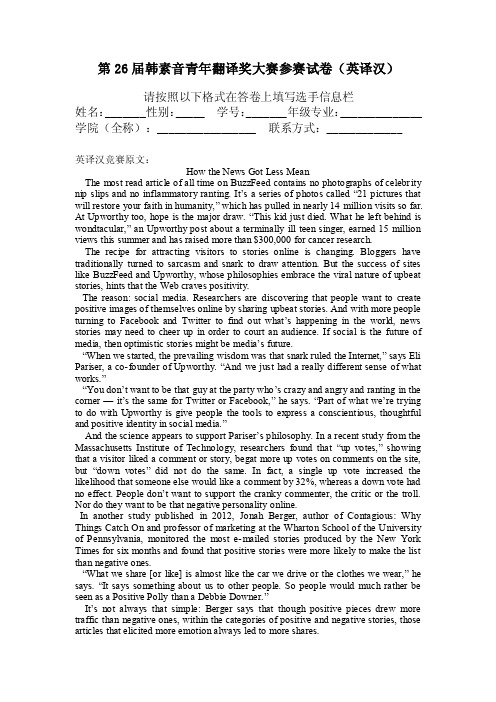
第26届韩素音青年翻译奖大赛参赛试卷(英译汉)请按照以下格式在答卷上填写选手信息栏姓名:_______性别:_____ 学号:_______年级专业:______________ 学院(全称):_________________ 联系方式:_____________英译汉竞赛原文:How the News Got Less MeanThe most read article of all time on BuzzFeed contains no photographs of celebrity nip slips and no inflammatory ranting. It’s a series of photos called “21 pictures that will restore your faith in humanity,” which has pulled in nearly 14 million visits so far. At Upworthy too, hope is the major draw. “This kid just died. What he lef t behind is wondtacular,” an Upworthy post about a terminally ill teen singer, earned 15 million views this summer and has raised more than $300,000 for cancer research.The recipe for attracting visitors to stories online is changing. Bloggers have traditionally turned to sarcasm and snark to draw attention. But the success of sites like BuzzFeed and Upworthy, whose philosophies embrace the viral nature of upbeat stories, hints that the Web craves positivity.The reason: social media. Researchers are discovering that people want to create positive images of themselves online by sharing upbeat stories. And with more people turning to Facebook and Twitter to find out what’s happening in the world, news stories may need to cheer up in order to court an audience. If social is the future of media, then optimistic stories might be media’s future.“When we started, the prevailing wisdom was that snark ruled the Internet,” says Eli Pariser, a co-founder of Upworthy. “And we just had a really different sense of what works.”“You don’t want to be that guy at the party who’s crazy and angry and ranting in the corner —it’s the same for Twitter or Facebook,” he says. “Part of what we’re trying to do with Upworthy is give people the tools to express a conscientious, thoughtful and positive identity in social media.”And the science appears to support Pariser’s philosophy. In a recent study from the Massachusetts Institute of Technology, researchers found that “up votes,” showing that a visitor liked a comment or story, begat more up votes on comments on the site, but “down votes” did not do the same. In fact, a single up vote increased the likelihood that someone else would like a comment by 32%, whereas a down vote had no effect. People don’t want to support the cranky commenter, the critic or the troll. Nor do they want to be that negative personality online.In another study published in 2012, Jonah Berger, author of Contagious: Why Things Catch On and professor of marketing at the Wharton School of the University of Pennsylvania, monitored the most e-mailed stories produced by the New York Times for six months and found that positive stories were more likely to make the list than negative ones.“What we share [or like] is almost like the car we drive or the clothes we wear,” he says. “It says something about us to other people. So people would much rather be seen as a Positive Polly than a Debbie Downer.”It’s not always that simple: Berger says that though positive pieces drew more traffic than negative ones, within the categories of positive and negative stories, those articles that elicited more emotion always led to more shares.“Take two negative emotions, for example: anger and sadness,” Berger says. “Both of those emotions would make the reader feel bad. But anger, a high arousal emotion, leads to more sharing, whereas sadness, a low arousal emotion, doesn’t. The same is true of the positive side: excitement and humor increase sharing, whereas contentment decreases sharing.”And while some popular BuzzFeed posts —like the recent “Is this the most embarrassing interview Fox News has ever done?” —might do their best to elicit shares through anger, both BuzzFeed and Upworthy recognize that their main success lies in creating positive viral material.“It’s not that people don’t share negative stories,” says Jack Shepherd, editorial director at BuzzFeed. “It just means that there’s a higher potential for positive stories to do well.”Upworthy’s mission is to highlight serious issues but in a hopeful way, encouraging readers to donate money, join organizations and take action. The strategy seems to be working: barely two years after its launch date (in March 2012), the site now boasts 30 million unique visitors per month, according to Upwort hy. The site’s average monthly unique visitors grew to 14 million people over its first six quarters — to put that in perspective, the Huffington Post had only about 2 million visitors in its first six quarters online.But Upworthy measures the success of a story not just by hits. The creators of the site only consider a post a success if it’s also shared frequently on social media. “We are interested in content that people want to share partly for pragmatic reasons,” Pariser says. “If you don’t have a g ood theory about how to appear in Facebook and Twitter, then you may disappear.”Nobody has mastered the ability to make a story go viral like BuzzFeed. The site, which began in 2006 as a lab to figure out what people share online, has used what it’s le arned to draw 60 million monthly unique visitors, according to BuzzFeed. (Most of that traffic comes from social-networking sites, driving readers toward BuzzFeed’s mix of cute animal photos and hard news.) By comparison the New York Times website, one of the most popular newspaper sites on the Web, courts only 29 million unique visitors each month, according to the Times.BuzzFeed editors have found that people do still read negative or critical stories, they just aren’t the posts they share with their friends. And those shareable posts are the ones that newsrooms increasingly prize.“Anecdotally, I can tell you people are just as likely to click on negative stories as they are to click on positive ones,” says Shepherd. “But they’re more likely to sh are positive stories. What you’re interested in is different from what you want your friends to see what you’re interested in.”So as newsrooms re-evaluate how they can draw readers and elicit more shares on Twitter and Facebook, they may look to BuzzFe ed’s and Upworthy’s happiness model for direction.“I think that the Web is only becoming more social,” Shepherd says. “We’re at a point where readers are your publishers. If news sites aren’t thinking about what it would mean for someone to share a story on social media, that coul be detrimental.”PS:1.请各位参赛选手关注我们的新浪微博:@安徽师范大学翻译协会2014,和腾讯微博:@安徽师范大学译协。
韩素音青翻译奖赛中文原文及参考译文和解析
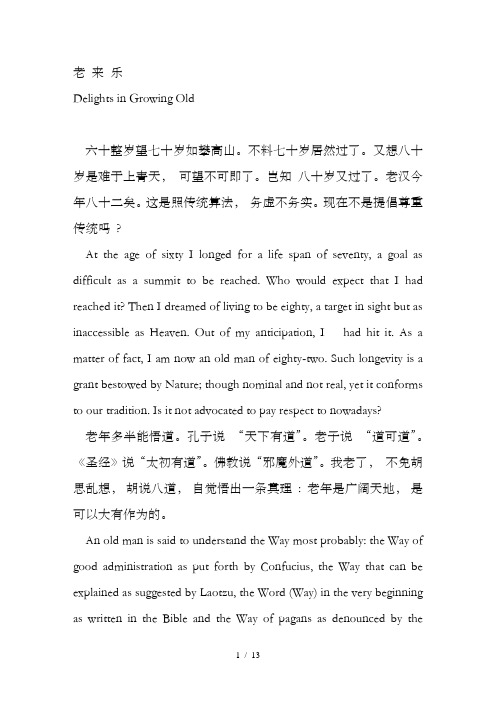
老来乐Delights in Growing Old六十整岁望七十岁如攀高山。
不料七十岁居然过了。
又想八十岁是难于上青天,可望不可即了。
岂知八十岁又过了。
老汉今年八十二矣。
这是照传统算法,务虚不务实。
现在不是提倡尊重传统吗?At the age of sixty I longed for a life span of seventy, a goal as difficult as a summit to be reached. Who would expect that I had reached it? Then I dreamed of living to be eighty, a target in sight but as inaccessible as Heaven. Out of my anticipation, I had hit it. As a matter of fact, I am now an old man of eighty-two. Such longevity is a grant bestowed by Nature; though nominal and not real, yet it conforms to our tradition. Is it not advocated to pay respect to nowadays?老年多半能悟道。
孔子说“天下有道”。
老子说“道可道”。
《圣经》说“太初有道”。
佛教说“邪魔外道”。
我老了,不免胡思乱想,胡说八道,自觉悟出一条真理: 老年是广阔天地,是可以大有作为的。
An old man is said to understand the Way most probably: the Way of good administration as put forth by Confucius, the Way that can be explained as suggested by Laotzu, the Word (Way) in the very beginning as written in the Bible and the Way of pagans as denounced by theBuddhists. As I am growing old, I can't help being given to flights of fancy and having my own Way of creating stories. However I have come to realize the truth: my old age serves as a vast world in which I can still have my talents employed fully and developed completely.七十岁开始可以诸事不做而拿退休金,不愁没有一碗饭吃,自由自在,自得其乐。
历届韩素音翻译大奖赛竞赛原文及译文
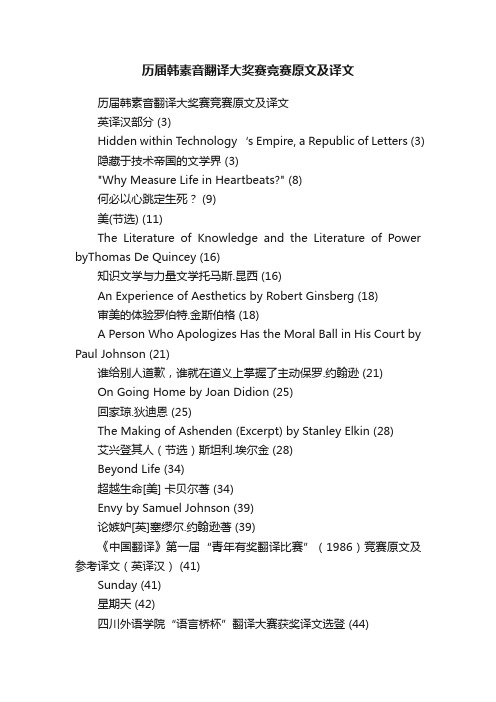
历届韩素音翻译大奖赛竞赛原文及译文历届韩素音翻译大奖赛竞赛原文及译文英译汉部分 (3)Hidden within Technology‘s Empire, a Republic of Letters (3)隐藏于技术帝国的文学界 (3)"Why Measure Life in Heartbeats?" (8)何必以心跳定生死? (9)美(节选) (11)The Literature of Knowledge and the Literature of Power byThomas De Quincey (16)知识文学与力量文学托马斯.昆西 (16)An Experience of Aesthetics by Robert Ginsberg (18)审美的体验罗伯特.金斯伯格 (18)A Person Who Apologizes Has the Moral Ball in His Court by Paul Johnson (21)谁给别人道歉,谁就在道义上掌握了主动保罗.约翰逊 (21)On Going Home by Joan Didion (25)回家琼.狄迪恩 (25)The Making of Ashenden (Excerpt) by Stanley Elkin (28)艾兴登其人(节选)斯坦利.埃尔金 (28)Beyond Life (34)超越生命[美] 卡贝尔著 (34)Envy by Samuel Johnson (39)论嫉妒[英]塞缪尔.约翰逊著 (39)《中国翻译》第一届“青年有奖翻译比赛”(1986)竞赛原文及参考译文(英译汉) (41)Sunday (41)星期天 (42)四川外语学院“语言桥杯”翻译大赛获奖译文选登 (44)第七届“语言桥杯”翻译大赛获奖译文选登 (44)The Woods: A Meditation (Excerpt) (46)林间心语(节选) (47)第六届“语言桥杯”翻译大赛获奖译文选登 (50)第五届“语言桥杯”翻译大赛原文及获奖译文选登 (52)第四届“语言桥杯”翻译大赛原文、参考译文及获奖译文选登 (54) When the Sun Stood Still (54)永恒夏日 (55)CASIO杯翻译竞赛原文及参考译文 (56)第三届竞赛原文及参考译文 (56)Here Is New York (excerpt) (56)这儿是纽约 (58)第四届翻译竞赛原文及参考译文 (61)Reservoir Frogs (Or Places Called Mama's) (61)水库青蛙(又题:妈妈餐馆) (62)中译英部分 (66)蜗居在巷陌的寻常幸福 (66)Simple Happiness of Dwelling in the Back Streets (66)在义与利之外 (69)Beyond Righteousness and Interests (69)读书苦乐杨绛 (72)The Bitter-Sweetness of Reading Yang Jiang (72)想起清华种种王佐良 (74)Reminiscences of Tsinghua Wang Zuoliang (74)歌德之人生启示宗白华 (76)What Goethe's Life Reveals by Zong Baihua (76)怀想那片青草地赵红波 (79)Yearning for That Piece of Green Meadow by Zhao Hongbo (79)可爱的南京 (82)Nanjing the Beloved City (82)霞冰心 (84)The Rosy Cloud byBingxin (84)黎明前的北平 (85)Predawn Peiping (85)老来乐金克木 (86)Delights in Growing Old by Jin Kemu (86)可贵的“他人意识” (89)Calling for an Awareness of Others (89)教孩子相信 (92)To Implant In Our Children‘s Young Hearts An Undying Faith In Humanity (92)心中有爱 (94)Love in Heart (94)英译汉部分Hidden within Technology’s Empire, a Republic of Le tters 隐藏于技术帝国的文学界索尔·贝娄(1)When I was a boy ―discovering literature‖, I used to think how wonderful it would be if every other person on the street were familiar with Proust and Joyce or T. E. Lawrence or Pasternak and Kafka. Later I learned how refractory to high culture the democratic masses were. Lincoln as a young frontiersman read Plutarch, Shakespeare and the Bible. But then he was Lincoln.我还是个“探索文学”的少年时,就经常在想:要是大街上人人都熟悉普鲁斯特和乔伊斯,熟悉T.E.劳伦斯,熟悉帕斯捷尔纳克和卡夫卡,该有多好啊!后来才知道,平民百姓对高雅文化有多排斥。
翻译评析:第二十二届韩素音青年翻译奖竟赛汉译英译文和译文评析 1

幸福是什么模样,或许并不难回答。幸福就是一本摊开的诗篇,关于在城市的天空下,那些寻常巷陌的诗。
Perhaps it is not so difficult to define happiness after all. Happiness is an unfurled scroll of poems, describing ordinary alleys under the city skies.
蜗居在巷陌的寻常幸福
Simple Happiness of Dwelling in the Back Streets
隐逸的生活似乎在传统意识中一直被认为是幸福的至高境界。但这种孤傲遁世同时也是孤独的,纯粹的隐者实属少数,而少数者的满足不能用来解读普世的幸福模样。
A secluded life has traditionally been deemed, as it seems, the supreme state of happiness, although such aloofness and retirement breed loneliness as well. Few people in fact end up as genuine recluses, whose contentment does not suffice to construe what happiness is for all.
和来家中做客的邻居朋友用同一种腔调巧妙地笑谑着身边的琐事,大家眯起的眼睛都默契地闪着同一种狡黠;和家人一起围在饭桌前,衔满食物的嘴还发着含糊的声音,有些聒噪,但没人厌烦。
When neighbors and friends come, they share witty jokes about personal trivialities, implicitly understanding each other's eye movements of like astuteness. Family members sit around the dining table, chattering through mouthfuls of food, and no one is bothered by the noise.
第二十七届韩素音青年翻译比赛汉译英优秀奖的译文教学内容
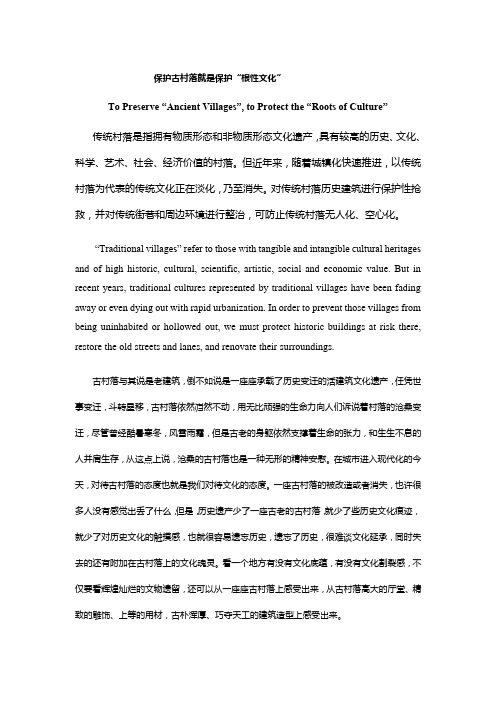
保护古村落就是保护“根性文化”To Preserve “Ancient Villages”, to Protect the “Roots of Culture”传统村落是指拥有物质形态和非物质形态文化遗产,具有较高的历史、文化、科学、艺术、社会、经济价值的村落。
但近年来,随着城镇化快速推进,以传统村落为代表的传统文化正在淡化,乃至消失。
对传统村落历史建筑进行保护性抢救,并对传统街巷和周边环境进行整治,可防止传统村落无人化、空心化。
“Traditional villages” refer to those with tangible and intangible cultural heritages and of high historic, cultural, scientific, artistic, social and economic value. But in recent years, traditional cultures represented by traditional villages have been fading away or even dying out with rapid urbanization. In order to prevent those villages from being uninhabited or hollowed out, we must protect historic buildings at risk there, restore the old streets and lanes, and renovate their surroundings.古村落与其说是老建筑,倒不如说是一座座承载了历史变迁的活建筑文化遗产,任凭世事变迁,斗转星移,古村落依然岿然不动,用无比顽强的生命力向人们诉说着村落的沧桑变迁,尽管曾经酷暑寒冬,风雪雨霜,但是古老的身躯依然支撑着生命的张力,和生生不息的人并肩生存,从这点上说,沧桑的古村落也是一种无形的精神安慰。
韩素音翻译大赛-英译汉一等奖

GlobalizationA fundamental shift is occurring in the world economy. We are moving rapidly away from a world in which national economies were relatively self-contained entities, isolated from each other by barriers to cross-border trade and investment; by distance, time zones, and language; and by national differences in government regulation, culture, and business systems. And we are moving toward a world in which barriers to cross-border trade and investment are tumbling; perceived distance is shrinking due to advances in transportation and telecommunications technology; material culture is starting to look similar the world over; and national economies are merging into an interdependent global economic system. The process by which this is occurring is commonly referred to as globalization.Correspondent: Globalization has been one of the most important factors to affect business over the last twenty years. How is it different from what existed before? Companies used to export to other parts of the world from a base in their home country. Many of the connections between exporting and importing countries had a historical basis. Today, to be competitive, companies are looking for bigger markets and want to export to every country. They want to move into the global market. To do this many companies have set up local bases in different countries. Two chief executives will talk about how their companies dealt with going global. Percy Barnevik, one of the world’s most admired business leaders when he was Chairman of the international engineering group ABB and Dick Brown of telecommunications provider Cable & Wireless.Cable & Wireless already operates in many countries and is well-placed to take advantage of the increasingly global market for telecommunications. For Dick Brown globalization involves the economies of countries being connected to each other and companies doing business in many countries and therefore having multinational accounts.Dick Brown: The world is globalizing and the telecommunications industry is becoming more and more global, and so we feel we’re well-positioned in that market place. You see currency markets are more global tied, economies are globally connected, more so nowadays with expanded trade, more and more multinational accounts are d oing business in many, many more countries. We’re a company at Cable & Wireless now, well-positioned to carry the traffic and to provide the services to more and more companies that now need to get to five countries or twelve countries, we’re often there.Correspondent: When Percy Barnevik became head of the international engineering group ABB, his task was to make globalization work. He decided to divide the business into over a thousand smaller companies. In this way he believed the company could be both global and local. In answering the question “How do you make globalization work?”, Percy Barnevik describes the “global glue” that keeps the many different people in ABB together. He then looks at the need to manage the three contradictions of company: it is decentralized but centrally controlled, it is big and small at the same time and it is both global and local.Percy Barnevik: We have now for ten years after our big merger created a “global glue” where people are tied together, where they don’t interna lly compete, but support each other, and you have global leaders with global responsibility and your local managers working with their profit centers, and if you have the right, so to say, agenda for these people and the right structure, you can use a scale of economy and your advantages of bigness but being small. We used to say you have three contradictions: decentralized and still centrally controlled, big and small, global and local, and, of course, to try to make these contradictions work together effectively, then I think youhave a big organizational competitive edge.Correspondent: Globalizations can bring advantage to a business, but how does a company go global? Dick Brown mentions three ways companies can achieve “globalness”. Firstly, companies can work together in alliances. Secondly, they can acquire or buy other companies, and thirdly they can grow organically by expanding from their existing base.Dick Brown: Well, as you go global, and a handful or more of companies are going to really push out, in my view, to be truly global companies, and some of them, maybe all of them, will also work to be local. They’ll be local in chosen markets and global in their ability to carry their customers’ needs from continent A to continent B. We want to be one of the companies that’s both global and local. Alliances are one way to be global, it’s not the only way to be global; you can acquire your way to “globalness”, you can organically grow your way to “globalness”, you can have alliances which help you get global quicker, so you take your pick.Percy Barnevik: You have to start from the top with local people who understand language, culture and so on, and I think in this global world where the East is coming up now, that’s a winning recipe.Correspondent: ABB already found the winning recipe. Its theory of globalization has become the company’s working practice. So how do you make theory work in practice? Percy Barnevik believes that successful globalization involves getting people to work together, overcoming national, cultural barriers and making the organization customer-driven.Percy Barnevik: You see the easy thing is to have the theory, but then to make the systems work, to make people really work together, to trust each other — Americans, Europeans, Asians, to get over these national cultural barriers and create a common glue, ABB, and then make them customer-driven. If you can achieve that, and create that culture deep down then I think you have an important competitive edge.Correspondent: What Dick Brown and Percy Barnevik have shown is that there are different routes to globalization and that companies have to work hard to succeed in going global. Actually one of the disadvantages of the Global Strategy is that integrated competitive moves can lead to the sacrificing of revenues, profits, or competitive positions in individual countries — especially when the subsidiary in one country is told to attack a global competitor in order to convey a signal or divert that competitor’s resources from another nati on. The challenges managers of transnational corporations face are to identify and exploit cross-border synergies and to balance local demands with the global vision for the corporation. Building an effective transnational organization requires a corporate culture that values global dissimilarities across cultures and markets.英译汉一等奖参赛译文来源:中国译协网EC301全球化1世界经济正在发生根本性的转变。
历届韩素音翻译大奖赛竞赛原文及译文详解
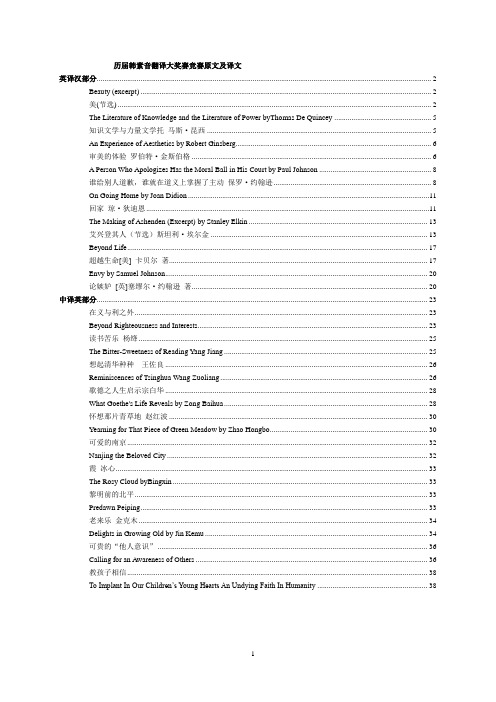
历届韩素音翻译大奖赛竞赛原文及译文英译汉部分 (2)Beauty (excerpt) (2)美(节选) (2)The Literature of Knowledge and the Literature of Power byThomas De Quincey (5)知识文学与力量文学托马斯.昆西 (5)An Experience of Aesthetics by Robert Ginsberg (6)审美的体验罗伯特.金斯伯格 (6)A Person Who Apologizes Has the Moral Ball in His Court by Paul Johnson (8)谁给别人道歉,谁就在道义上掌握了主动保罗.约翰逊 (8)On Going Home by Joan Didion (11)回家琼.狄迪恩 (11)The Making of Ashenden (Excerpt) by Stanley Elkin (13)艾兴登其人(节选)斯坦利.埃尔金 (13)Beyond Life (17)超越生命[美] 卡贝尔著 (17)Envy by Samuel Johnson (20)论嫉妒[英]塞缪尔.约翰逊著 (20)中译英部分 (23)在义与利之外 (23)Beyond Righteousness and Interests (23)读书苦乐杨绛 (25)The Bitter-Sweetness of Reading Yang Jiang (25)想起清华种种王佐良 (26)Reminiscences of Tsinghua Wang Zuoliang (26)歌德之人生启示宗白华 (28)What Goethe's Life Reveals by Zong Baihua (28)怀想那片青草地赵红波 (30)Yearning for That Piece of Green Meadow by Zhao Hongbo (30)可爱的南京 (32)Nanjing the Beloved City (32)霞冰心 (33)The Rosy Cloud byBingxin (33)黎明前的北平 (33)Predawn Peiping (33)老来乐金克木 (34)Delights in Growing Old by Jin Kemu (34)可贵的“他人意识” (36)Calling for an Awareness of Others (36)教孩子相信 (38)To Implant In Our Children’s Young Hearts An Undying Faith In Humanity (38)英译汉部分Beauty (excerpt)美(节选)Judging from the scientists I know, including Eva and Ruth, and those whom I've read about, you can't pursue the laws of nature very long without bumping撞倒; 冲撞into beauty. “I don't know if it's the same beauty you see in the sunset,”a friend tells me, “but it feels the same.”This friend is a physicist, who has spent a long career deciphering破译(密码), 辨认(潦草字迹) what must be happening in the interior of stars. He recalls for me this thrill on grasping for the first time Dirac's⑴equations describing quantum mechanics, or those o f Einstein describing relativity. “They're so beautiful,” he says, “you can see immediately they have to be true. Or at least on the way toward truth.” I ask him what makes a theory beautiful, and he replies, “Simplicity, symmetry .对称(性); 匀称, 整齐, elegance, and power.”我结识一些科学家(包括伊娃和露丝),也拜读过不少科学家的著作,从中我作出推断:人们在探求自然规律的旅途中,须臾便会与美不期而遇。
第23届韩素音青年翻译奖竞赛汉译英原文
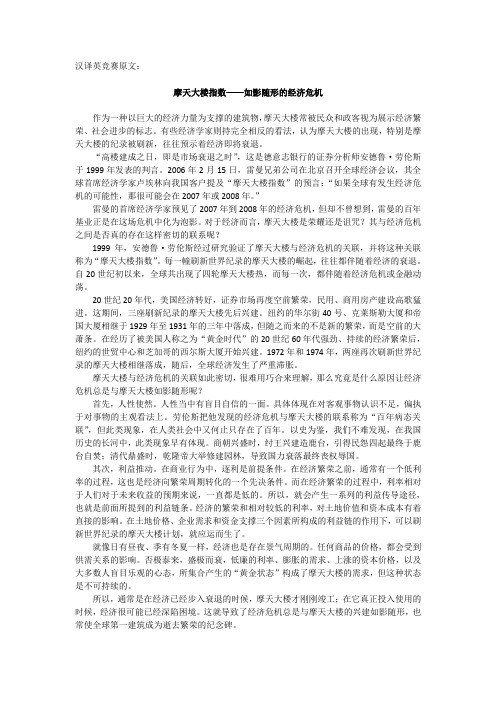
汉译英竞赛原文:摩天大楼指数——如影随形的经济危机作为一种以巨大的经济力量为支撑的建筑物,摩天大楼常被民众和政客视为展示经济繁荣、社会进步的标志。
有些经济学家则持完全相反的看法,认为摩天大楼的出现,特别是摩天大楼的纪录被刷新,往往预示着经济即将衰退。
“高楼建成之日,即是市场衰退之时”,这是德意志银行的证券分析师安德鲁·劳伦斯于1999年发表的判言。
2006年2月15日,雷曼兄弟公司在北京召开全球经济会议,其全球首席经济学家卢埃林向我国客户提及“摩天大楼指数”的预言:“如果全球有发生经济危机的可能性,那很可能会在2007年或2008年。
”雷曼的首席经济学家预见了2007年到2008年的经济危机,但却不曾想到,雷曼的百年基业正是在这场危机中化为泡影。
对于经济而言,摩天大楼是荣耀还是诅咒?其与经济危机之间是否真的存在这样密切的联系呢?1999年,安德鲁·劳伦斯经过研究验证了摩天大楼与经济危机的关联,并将这种关联称为“摩天大楼指数”。
每一幢刷新世界纪录的摩天大楼的崛起,往往都伴随着经济的衰退。
自20世纪初以来,全球共出现了四轮摩天大楼热,而每一次,都伴随着经济危机或金融动荡。
20世纪20年代,美国经济转好,证券市场再度空前繁荣,民用、商用房产建设高歌猛进。
这期间,三座刷新纪录的摩天大楼先后兴建。
纽约的华尔街40号、克莱斯勒大厦和帝国大厦相继于1929年至1931年的三年中落成,但随之而来的不是新的繁荣,而是空前的大萧条。
在经历了被美国人称之为“黄金时代”的20世纪60年代强劲、持续的经济繁荣后,纽约的世贸中心和芝加哥的西尔斯大厦开始兴建。
1972年和1974年,两座再次刷新世界纪录的摩天大楼相继落成,随后,全球经济发生了严重滞胀。
摩天大楼与经济危机的关联如此密切,很难用巧合来理解,那么究竟是什么原因让经济危机总是与摩天大楼如影随形呢?首先,人性使然。
人性当中有盲目自信的一面。
具体体现在对客观事物认识不足,偏执于对事物的主观看法上。
第28届韩素英
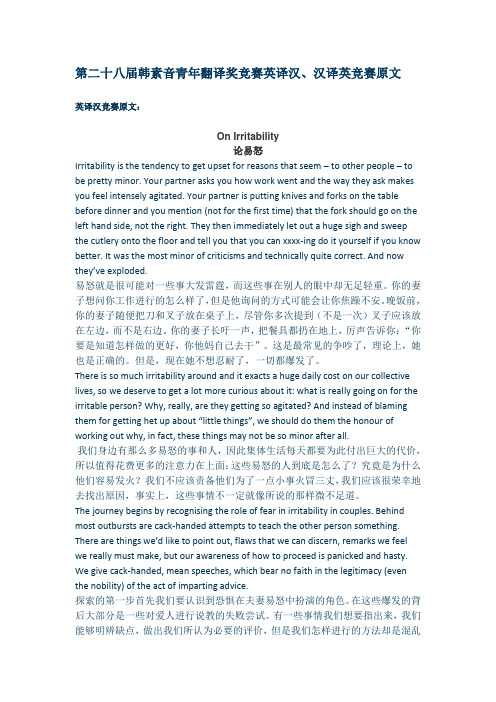
第二十八届韩素音青年翻译奖竞赛英译汉、汉译英竞赛原文英译汉竞赛原文:On Irritability论易怒Irritability is the tendency to get upset for reasons that seem – to other people – to be pretty minor. Your partner asks you how work went and the way they ask makes you feel intensely agitated. Your partner is putting knives and forks on the table before dinner and you mention (not for the first time) that the fork should go on the left hand side, not the right. They then immediately let out a huge sigh and sweep the cutlery onto the floor and tell you that you can xxxx-ing do it yourself if you know better. It was the most minor of criticisms and technically quite correct. And now they’ve exploded.易怒就是很可能对一些事大发雷霆,而这些事在别人的眼中却无足轻重。
你的妻子想问你工作进行的怎么样了,但是他询问的方式可能会让你焦躁不安。
晚饭前,你的妻子随便把刀和叉子放在桌子上,尽管你多次提到(不是一次)叉子应该放在左边,而不是右边。
你的妻子长吁一声,把餐具都扔在地上,厉声告诉你:“你要是知道怎样做的更好,你他妈自己去干”。
韩素音翻译大赛英译汉
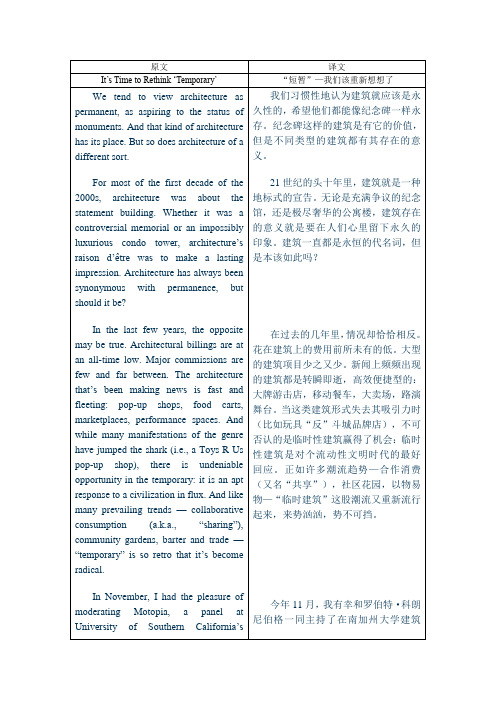
原文
译文
It’s Time to Rethink ‘Temporary’
“短暂”—我们该重新想想了
We tend to view architecture as permanent, as aspiring to the status of monuments. And that kind of architecture has its place. But so does architecture of a different sort.
In November, I had the pleasure of moderatingMSouthern California’sSchool of Architecture, with Robert Kronenburg, an architect, professor at University of Liverpool and portable/temporary/mobile guru. Author of a shelf full of books on the topic, including “Flexible: Architecture that Responds to Change,” “Portable Architecture: Design and Technology” and “Houses in Motion: The Genesis,” Kronenburg is a man obsessed.
翻译的理解与表达第十七届韩素音青年翻译奖英译汉参考译文简评

(++,年 )月 第 (W 卷 第(期外语教学X Y Z [\]^_‘^]a ‘][b c a d ‘e \Y ^ f K =5(++,h >H 5(W i >5(g g gg g gg gg g gg gg gg g gg gg g gg gg g gg gg g gg gg g gg gg g gg gg gg g gg gg g gg gg g gg gg g gg gg翻译的理解与表达!! "第十七届#韩素音青年翻译奖$英译汉参考译文%简评 黎土旺&东 莞理工学院 外语系 广东 东莞 ’()*+,-另外 2"书 中读到的科学家们 %过 于拘泥于原文的形式 1不一 .引 言 如 依 照 上 下 文 理 解 2从 功 能 交 际 的 目 的 适 当 地 增 加 一 些 解 释 由 中国译协 /中 国翻译 0编 辑部和中南大学外国语学院联 性 的内容 2将 全句译为 3"从 书本中所了解到的科学家 &的 经历 合 举办的第十七届 "韩 素音青年翻译奖 %比 赛已经结束 1 该项 来 看 -%2读 来也许会更顺畅些 1全句拟译为 3"从 我所认识的 2活动为鼓励 .培 养和发现全国各地优秀翻译人才 2为 繁荣我国 的 翻 译 事 业 做 出 了 很 大 的 贡 献 2在 全 国 英 语 学 习 及 翻 译 领 域 产生了很大的影响 1包括伊娃和鲁思 2以 及我从书本中所了解到的科学家 &的 经历 来 看 -2只 要 去 探 寻 自 然 法 则 2不 用 多 久 2必 有 与 美 邂 逅 的 一 天 1%作 为 此 项 活 动 的 热 心 者 2笔者 拜 读 过 主 办 方 刊 出 的 参 考 例 (3P >7 D K ; 8>C D :B ;D B G :@A >7@M B H :B J :;9 :; K 8:J :;B译文 2产 出了一番感慨 1参与此项活动的举办方 .协 办方专家. 学者以及工作人员 2从 选取参赛原文 2制 定正确的翻译原则和 标准 2拟 定参考译文 2及 至认真审校 .公 正地评选参赛译稿 2历 时 数 月 2酸 甜 苦 辣 2非 局 内 人 所 能 体 会 2他 们 的 工 作 应 该 得 到 译界的充分肯定 1 Q B 9:C H K @>=2M 7@;>@G :@A >7@M B H :B J :;9:;H K G C 1 参 考 译 文 3"从 事 科 学 研 究 可 不 信 上 帝 立 法 之 说 2但 决 不 可不信其法则的存在 1% 此句中的 "其 法则 %究 竟为何法则R 谁的法则R 由于 /参 考 译 文 0忽 略 了 "H K G C%一 词 的 "情 景 语 境 %2仅 仅 从 语 言 结 构 本本 次 英 译 汉 参 考 译 文 对 原 文 的 理 解 大 体 准 确 2表 达 也 比 身 2从 语言的体现形式来理解 2便 把 "H K G C%一 词译成了 "上 帝较到位 2比 较得体 2行 文比较流畅 2其 中不乏妙笔生辉之句 1然 而 2"天 下 绝 不 存 在 完 美 无 缺 的 译 作 2即 使 再 好 的 译 文 也 难 免 会 有 这 样 那 样 的 缺 陷 %&孙 致 礼 2(+++3(4+-2尤 其 是 一 项 涉 及 面 广 泛 的 奖 项 活 动 2工 作 千 头 万 绪 2出 现 疏 漏 2甚 至 误 解 或 者 偏差也在所难免 1仁者见仁 2智 者见智 2不 同的译文会有不同 立 法 的 "法 则 %1 莫 非 从 事 科 学 研 究 一 定 要 相 信 上 帝 所 立 "法 则 %的 存在R 实际上 2借 助上下文情景理解 2此 "法 则 %即 在上一 句所提到的 "KD >A B =B ;@C B @><=7H B C%2应 作 "自 然法则 %或 "自 然 规 律 %解 1 故 此 句 拟 译 为 3"从 事 科 学 研 究 可 不 信 上 帝 立 法 之 说 2但 决不可忽视自然法则的存在 1%的理解 2不 同的译者会产出不同的译文 2对 千变万化的文学翻 例 )3S 7@@A K @:C K M >7@K H H @A K @E $J B F B O @<=>? @A B译 来 说 都 是 可 以 理 解 的 2进 行 善 意 的 批 评 和 自 我 批 评 也 是 可 以接受的 1基 于此 2笔 者就参赛译文中需要改进的地方提出一 些浅陋的看法 2供 学界批评指正 1二 ./参 考译文 0中 出现的偏差 H K ;97K 9B C ><;7?M B =C1 参 考 译 文 3"但 就 数 字 符 号 而 言 2就 已 穷 尽 我 毕 生 所 学 了 1%这句 话 不 可 译 成 "穷 尽 我 毕 生 所 学 %1 首 先 2"F B B O %既 为 "保 留 %."保 持 %2句 中 "K H H @A K @E $J B F B O @%应 为 "迄 今 仍 然 所 持 *5理 解失误 .表 达欠妥有的全部 !! %1作 者意指从前所学数学 2时 至今日已忘不少 2在翻译过程中 2译 者首先必须了解原作者的创作意图 2从 整体出发 2反 复琢磨原文中的每个细节 1只 有当译者将原文中 的每个细节与整体真正融会贯通 2才可能保证理解到位 1由 于 未 能 对 原 文 中 所 出 现 的 某 些 简 单 的 语 法 现 象 加 以 重 视 2未 能 所剩下的仅可做些代数 .几 何和三角一类的运算了 1 其次 2作 为 曾攀登过数学之峰 2能 在数学领域里品味出 "美 %的 作者 2其 毕生所学岂止会些代数 .几 何和三角一类的运算R 译文注释中强调 "H K ;97K 9B ><;7?M B =C%是 "数 字符号 %2不 仔 细推敲原文中部分词 .句 的内涵 2/参 考译文 0在 上下文承接是 "数 字 语 言 %1 其 实 2"数 字 符 号 %也 好 2"数 字 语 言 %也 罢 2和呼应方面 2在 整体语篇的风格 .主 题表达意境等方面都表现 出种种不足 2多 处出现理解失误 1例 *36789:;9<=>? @A BC D :B ;@:C @CE F ;>G 2:;D H 78:;9I J K "H K ;97K 9B ><;7?M B =C %在 整个这一段里根本就是 "数 学 %的 意 思 1翻译时没有必要如此生搬硬套 1如此 2不 如译为 3"时 至今 日 2我 尚能派上用场的全部数学功底也就这些了 1%K ;8L 7@A 2K ;8@A >C B G A >? E $J B =B K 8K M >7@2N >7D K ;$@O 7=C 7B 例 43T @:H H 2E =B ?B ?M B =9H :?O C :;9O K @@B =;C :;?K @A B ?K @:D C @A BH K G C ><;K @7=B J B =NH >;9G :@A >7@M 7?O :;9:;@>M B K 7@N 5 参 考译文 3"我 认识的 &包 括伊娃和鲁思认识的 -和 书中读 到 的 科 学 家 们 都 认 为 2只 要 去 探 寻 自 然 法 则 2不 用 多 久 2必 有 与美邂逅的一天 1%我 们 认 为 2第 一 个 句 子 的 正 确 理 解 应 该 是 "从 我 所 认 识 的 2包 括 &*-I J K 2K ;8&(-L 7@A 2K ;8&)-@A >C B G A >?E $J B =B K 8K M >7@等 科学家 &的 经历 -来 看 %2可 是在 /参 考译文 0中 2此 句译 为 "包 括 伊 娃 和 鲁 思 认 识 的 %1 ":;D H 78:;9%后 面 的 "I J KK ;8@A K@C B B?B8K C M>H8K;8M B K7@:<7H K CKC F N<7H><C@K=C1参考译文3"至今我仍记得2一瞥之下2那些数学模式恰如满天繁星闪烁2曾是那般美丽而耀眼1%作者在整个这一段落里论及的是"数学之美%1"=B?B?M B=9H:?O C:;9U U %这一短语并非仅仅"记得%或"一瞥%那么简单2它是对其青少年时期攀登数学之峰所遇见的数学模式之"美%的回味2乃至陶醉1我们以为应对该词加以适度的改正2将"=B?B?M B=%译为"常常想起%."常常回味%1还有"C B B?B8%一词虽为过去分词2但译成L7@A%没能被万当方作数"@据A BC D:B;@:C@C%的补语来处理2是理解失误1"曾是%2则其陶醉不已的"数学模式%便具有现在已不再美丽V W W V-..1年Z月第-N卷第-期外语教学^_‘a b c de f d c g f c a h i g j f k b_d[#’H-..1m:E H-N n:H-llll lll lll llll lll lll lll lll lll lll lll llll lll lll lll lll lll lll llll lll lll l耀眼之意!这样有违"#$%&’(教授感慨)数学之美*的原意!这是对英文中过去分词的误解+可以在汉语中将其还原为现在时!)为使过去的事情变得更具现实性+更加生动+更加缩短文本与读者的距离+用现在时来体现是一个重要手段*,罗选民+ -../0/112!这样处理可以让读者产生一种身临其境的感觉!参考译文0)当问及何为理论之美+答曰0)简洁P对称P 典雅P力量*!Q参考译文R在此句的处理上+虽尽力做到了与原文形式上的一致+但由于未能兼顾整体与细节的关系+导致多处词义翻译不当!)&E&9#$<&*作)典雅*解时+通常有较为)隆重*P)厚我们可以将此句译为0)时至今日我仍旧记得+那些恰如满天重*之义+若与)简洁*并置+便显得自相矛盾!在字典里+繁星闪烁的数学模式竟是那般美丽而耀眼!*)&E&9#$<&*本来就有)(<8&$68D8<&S#<6$&((#$%;’&<8(8:$*,科学例304567&$&&%6’#8$8$98$:’%&’6:;&’<&8=&>:’&6?#$上的精确和简明2之含义+所以+将其译成)精确*更妥!还有+6?&>:(6:@=8:5(A8$%(!);:7&’*除了是)力量*外+还有)D:’<&D5E$&((+&D D&<68=&$&((*参考译文0)若要从最显见的物类中获得更多美的感悟+ 则须经专门训练!*在此句中+比较级)>:’&6?#$*和最高级)6?&>:(6*这两个简单的语法现象未能得到足够的重视!英语表达中+)>:’& 6?#$B$:5$*常有)不仅仅是*之义!如果参照上下文+把二者组合排列来看+意思就十分明白了!)6:;&’<&8=&>:’& ,@8C26?#$6?&>:(6:@=8:5(A8$%(,:D@8C2*可以直译为)从最显见的美以外领悟更多的美*!可见作者并不是要)从最显见的物类中*获得更多美的感悟+而是要)从最显见的物类*以外获得更多美的感悟!例3似应译为0)要想领悟深藏于自然界中更多的美+则须经专门训练!*例1045686<#$$:6 %&E8=&’6:5(6?&’#%8#$<&7& #;;’&?&$% 8$6?&7:’E%+#$C>:’&6?#$#;?:6:9’#;?<#$ <#;65’&6?&(65$$8$9(78D6$&((:D#?#7A:’6?&786?&’8$9 ;:7&’:D#(5;&’$:=#!参考译文0),语言2却无法言传人们在世间感悟的那番美的意境+这恰如照片不能捕捉飞鹰掠天的惊人迅疾与超新星,有说服力2的意思+如0)#$:=&E:D5$5(5#E;:7&’*+可译成)一部极具说服力的小说*+所以+此句宜译为)有,说服2力*F 然而+该句最大的不足在于0原作文笔流畅+一气呵成!译文的文体风格前后不一致+文言与白话夹杂+犹如油画与年画杂合+让人难以接受!此句可译为0)当问及理论缘何具有如此魅力时+他的回答是0简洁P对称P精确P有力!*例L0T&;5U U E&:56D:’>5E#(+6&(66?&>+#$%D8$%+6:#$ #(6:$8(?8$9%&9’&&+6?#6$#65’	’&&(!参考译文0)人类推导出的各种公式定理+几经验证+竟发现与自然界惊人的一致!*)各种公式定理*如何与)自然界*)一致*F而且)公式定理*也不可能做出只有人类才可)发现*的动作!由于Q参考译文R在处理这一句子时有些只顾细节+忽视整体I只重形式+淡薄内容+导致一些译文经不起推敲+有明显的语病!)公式定理*应该与隐含的,自然界的2)发展规律*相比+所以+此句宜译为0)人类推导出的各式公式定理+经过验证+竟然与自然界的发展规律如此惊人地相符!爆耀的摄人威力一样!*例J0V’?#=&7&(65>@E&% :$6:# %&&;<:$9’5&$<&照片不能捕捉)飞鹰掠天的惊人迅疾*吗F电影不是照片@&67&&$6?&(6’5<65’&:D:5’>8$%(#$%6?&(6’5<65’&:D6?&拍摄而成的吗F例1参考译文的关键问题在于把)>:’&6?#$* 给漏译了F此句的完整形式应是)E#$95#9&<#$%&E8=&’*与5$8=&’(&F参考译文0)还是人脑构造与宇宙天体碰巧契合呢F*);?:6:9’#;?<#$<#;65’&*作比较!即0)G#$95#9&<#$$:6该句译文同属病句!)人脑构造*与)天体*不具等效相比!%&E8=&’6:5(#$C>:’&:D6?&(65$$8$9(78D6$&((:D#?#7A:’6?&786?&’8$9;:7&’:D#(5;&’$:=#6?#$#;?:6:9’#;?<#$ %:!*所以+更贴切的译文应为0),语言2无法言传人们在世间感悟的那种美的意境+更不能如照片那样捕捉飞鹰掠天的惊人迅疾与超新星爆耀时的摄人威力!*-H词义不确定+文体不统一从翻译研究的语篇分析方法来看+)意义并非由语言结构本身决定+而是由整个语篇,包括它的语言体现形式和它的交际功能2来决定I翻译中传递的是原文的语言含义和语言使用,即交际2功能*,张美芳+-..30/..2!同时+)在交际过程中+语言的意义通常是根据语境来确定的!同一个语言单位在不同的语境中有不同的意义*,张美芳+-..30/.32!这正如奈达与泰伯,/J1J K/J L-0/3M/12所指出的+词汇不仅仅是)意义点*+由于不同语言的对应词所涵盖的语义范围不同+翻译某个源语原文将)人类*与)自然界*相此+所言的是)人脑*结构与)天体*构造之契合与否!若是在)宇宙天体*之后加上)构造*二字+译文就容易理解了!例/.0T&E&#’$6:(#=:’#E E(:’6(:D;#66&’$(+D’:> W5#$65>>&<?#$8<(6:;#6<?7:’A W58E6(!参考译文0)人类学会鉴赏天地万化之模式+从量子力学到百纳被无所不包!*翻译目的意在为读者所读懂!将);#6<?7:’A W58E6(*译成)百纳被*不易被读者接受!);#6<?7:’A W58E6(*指)普通百姓所用的拼缝床罩*+并非现代生活中常用的物品+年轻读者不借助词典难以理解其为何物!笔者为此曾做过问卷调查+将这句话写在纸上+让在校大学生和研究生回答解释)百纳被*是什么时+十二个调查对象中+只有一个来自农村的同学似乎听人说过X百纳被Y一词I三位同学以为)百纳被*是高科技产品I 其词项时+要根据语境而非固定的对应体系选择相应的目标语余同学对此一无所知!故此译宜加注)百纳被*0,一种拼缝被+词项!在翻译实践中+一些最常见词语的词义不能仅仅凭据词典来获取!我们应该从上下文中去深究其真正的内蕴+从整体上去理解其逻辑内涵+找出其言外因素!此外+还要把个别的词和短语同整篇文体结合来考虑+这样方可避免理解和表达出现的偏差+例N至例/.便是这种情况!例N0O#(A&%?8>7?#6>#A&(#6?&:’C@ȸD5E+#$%?&居家所用2!ZH超额翻译与欠额翻译在翻译过程中+译文的信息量可能少于或大于原文+纽马克,[#’A"?566E&7:’6?#$%[:’8#\:78&+-..30/1-2称这种现象为)超额翻译*和)欠额翻译*!他认为+每一个翻译行为都会不可避免地导致原文本意义的走失+这就使译者不得不根’&;E8&(+)"8>万;E方8<8数6C+据(C>>&6’C+&E&9#$<&+#$%;:7&’H*据具体语境+在目标文本中或增加细节+或进行宽泛化处理!]N L]’((F年M月第’s卷第’期外语教学%&’()*+,-+*.-*(/0.1-2)&+Q5<R’((F49E R’sJ9R’33333333333333333333333333333333333333333333333333333333333333333333在翻译实践中!"有些信息对原语读者来说很有意义!而对目的语读者却不然#有的信息对原语读者来说用处不大!而对目的语读者却非常有用$这样!译者就要根据自己的判断对原文中的信息进行取舍或增减!使之适合目的语读者的需求%&张美芳!’(()*+,-.$在/参考译文0中出现的超额翻译与欠额翻译情况有*例++*123456278398:2762;:<7=3=23>3:9<?> 34@9?73>2A8?<3?>9B78>7C2=>78=9=23:9<D78C>9B=23 45=3<75E:9<E?$"这镜片是遵循首次由艾萨克K牛顿阐释的光学原理研制而成$%三L结语尽管出现了以上几个方面的疏漏!但/参考译文0基本上还是达到了评审委员会所制定的标准!基本上传达了原文的神采和风韵$如同历届翻译奖竞赛活动一样!此次活动对推动我国翻译事业的发展起到了积极的作用$由于这一赛事活动影响面广!参与者多!举办方在拟定/参考译文0时还可以更加参考译文*"我用来打字的这台电脑!同样是人类千百次广泛地征求意见!更加深入地查证!把错误减少到最低程度!探索与认知物质世界的结晶$%原文没有刻意采用描绘性的言辞对其"论美%作任何意象渲染$作者所用词汇普通!意义却十分鲜明$句中"=23>3%虽看似简单!其感情色彩却极为深厚!将其漏译实属不该$"从语篇分析方面看!不少词汇与造句都能体现话语交际的距离!如在指示代词中!=27>!=23>3!23<3和89:表示近!而=25=!=29>3!这样便能更好地对参赛者负责!对此项活动的信誉负责!对学术负责$以上有不妥之处!请专家L学者及同仁斧正$参考文献N+O P62A==E3:9<=2!Q5<D58?Q R S9:73R T U V W U X Y Z[\X]^[Z Y_‘Z W U X Ya Wbc U d_N e O R谭载喜主译R北京*外语教学与研究出版社!’(()R=23<3和=238表示远%&罗选民!’((+*+F F.$所以!充分利用此N’O J7?5!f A C383g R h S25<E3>i R15@3<R^j d^j d X[\Z Y ck[Z V W U V d词的"近%意!可将读者与原作者的距离拉近!使其在感情上产生共鸣$此句宜译为*"我用来写作的这台电脑!同样是人类千百次探索与认知物质世界的结晶$%X]^[Z Y_‘Z W U X Y N Q O R l37?38*f R m R n<7E E!+o F o p+o-’RN M O罗选民R话语分析的英汉语比较研究N QO R长沙*湖南人民出版社!’((+R例+’*GG=25=9@3H=23E5:>9B9I=76>B7<>=:9<D3?9A=N,O孙致礼R谈新时期的翻译批评N g OR谢天振主编R翻译的理论建78?3=57E@H;>556J3:=98$参考译文*"GG这镜片又是遵循艾萨克K牛顿当年阐释的光学原理研制而成$%无论是英译汉还是汉译英!增词是必不可少的翻译环节! 但增词决不是译者随心所欲L天马行空的挡箭牌&徐莉娜! ’(()*+,M.$在这句中!出现了超额和欠额翻译各一次$该段文本前面并没有论及过艾萨克K牛顿的任何其它原理!译者在/参考译文0中擅自增加"又%字一词应为不妥$构与文化透视N S O R上海*上海外语教育出版社!’(((RN)O徐莉娜R增词译法的语义GG句法路径N g O R罗选民主编R语言认知与翻译研究N S O R北京*外文出版社!’(()RN F O张美芳R翻译研究的功能途经N QO R上海*上海外语教育出版社! ’(()R作者简介*黎土旺!东莞理工学院外语系副教授!清华大学访问学者!研究方向*翻译理论与实践L翻译研究语料库$另外!"首次%恐怕不能由"当年%来替代$或许译者对于艾收稿日期’(()q++q’o萨克K牛顿究竟是不是首个阐释"光学原理%者仍有疑问!故特意避而不译$恰恰是这不译!造成了信息不足$建议改译为*责任编校石春让rrrrrrrrrrrrrrrrrrrrrrrrrrrrrrrrrrrrrrrrrrrrrrrrrrr全国语用学讲习班为了推进我国语用学学习与研究!把握当代语用学的研究主题及发展趋势!广东外语外贸大学外国语言学及应用语言学研究中心&教育部人文社科重点研究基地.与中国语用学研究会计划于’((F年s月举办全国语用学讲习班$特邀的主讲教授与题目*+.关联理论提出者L英国t87u3<>7=HS9E E3C3l98?98的v37<?<3w7E>98教授!题目*&5.E3x765E I<5C45=76>#&@.>3458=76p I<5C45=76?7>=786=798#&6.3x I E767=p74I E767=?7>=786=798#&?.56y A7>7=7989B I<5C45=76>’.z X b[Y Z‘X]k[Z{|Z W U V_创刊主编L丹麦t87u3<>7=H9B i9>D7E?3的}5<=4A=}5@3<E58?教授!题目*&5.I<5C45=76>5>5>A@q7>67I E7839BE78C A7>=76>u>R I<5C45=76>5>5:5H9B?978C E78C A7>=76>#&@.I<5C45=76>58?=23?7u3<>7=H9BE58C A5C3>#&6. I<5C45=76>58?=<58>E5=798#&?.=23I<5C45=76>9B B<9~38?7>69A<>3*=3x=58?I<5C45=76>M.香港大学陆镜光&!R!R l A D3.教授!题目*&5.=2343=29?9E9C H9B698u3<>5=798585E H>7>#&@.C<5445<58??7>69A<>3应邀的主讲学者还有*徐盛桓教授&河南大学.L何自然教授&广外.L钱冠连教授&广外.L冉永平教授&广外.L莫爱屏教授&广外.L张新红博士&广外.L徐章宏博士&广外.$具体日期*’((F年s月’,"M+日!共-天$收费标准*F((元&研究生)((元.p每人!包括听课费L资料费#其他费用自理$ 工作语言*英语L汉语报名时间*’((F月M月+日开始接受报名$联系方式*电话*(’(q M F’(s’(+#电子邮件*C I I2?#457E R C?A B>R3?A R68 其他信息详见*2==I*p p:::R6I<5R694R68或2==I*p p:::R6E5E R9<C R68欢迎外万语方界L数汉据语界的研究生L教师及语用学爱好者参加$Ks o K。
第二十七届韩素音青年翻译比赛汉译英优秀奖的译文
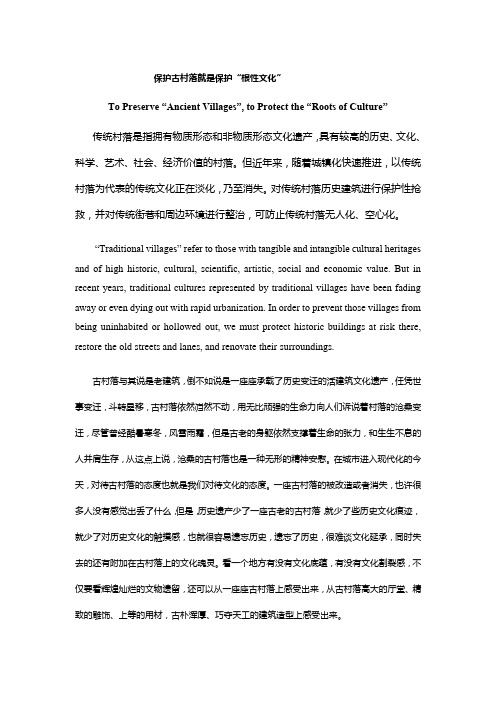
保护古村落就是保护“根性文化”To Preserve “Ancient Villages”, to Protect the “Roots of Culture”传统村落是指拥有物质形态和非物质形态文化遗产,具有较高的历史、文化、科学、艺术、社会、经济价值的村落。
但近年来,随着城镇化快速推进,以传统村落为代表的传统文化正在淡化,乃至消失。
对传统村落历史建筑进行保护性抢救,并对传统街巷和周边环境进行整治,可防止传统村落无人化、空心化。
“Traditional villages” refer to those with tangible and intangible cultural heritages and of high historic, cultural, scientific, artistic, social and economic value. But in recent years, traditional cultures represented by traditional villages have been fading away or even dying out with rapid urbanization. In order to prevent those villages from being uninhabited or hollowed out, we must protect historic buildings at risk there, restore the old streets and lanes, and renovate their surroundings.古村落与其说是老建筑,倒不如说是一座座承载了历史变迁的活建筑文化遗产,任凭世事变迁,斗转星移,古村落依然岿然不动,用无比顽强的生命力向人们诉说着村落的沧桑变迁,尽管曾经酷暑寒冬,风雪雨霜,但是古老的身躯依然支撑着生命的张力,和生生不息的人并肩生存,从这点上说,沧桑的古村落也是一种无形的精神安慰。
第28届韩素音翻译比赛汉译英原文和参考译文(下)
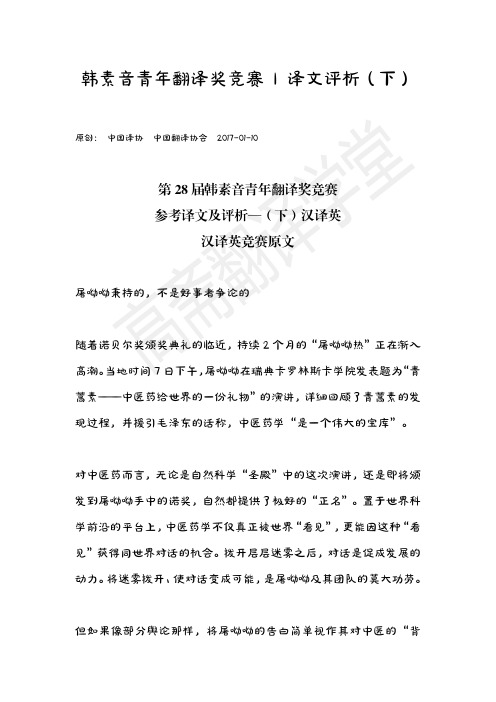
韩素音青年翻译奖竞赛 | 译文评析(下) 原创: 中国译协 中国翻译协会 2017-01-10第28届韩素音青年翻译奖竞赛参考译文及评析—(下)汉译英汉译英竞赛原文屠呦呦秉持的,不是好事者争论的随着诺贝尔奖颁奖典礼的临近,持续2个月的“屠呦呦热”正在渐入高潮。
当地时间7日下午,屠呦呦在瑞典卡罗林斯卡学院发表题为“青蒿素——中医药给世界的一份礼物”的演讲,详细回顾了青蒿素的发现过程,并援引毛泽东的话称,中医药学“是一个伟大的宝库”。
对中医药而言,无论是自然科学“圣殿”中的这次演讲,还是即将颁发到屠呦呦手中的诺奖,自然都提供了极好的“正名”。
置于世界科学前沿的平台上,中医药学不仅真正被世界“看见”,更能因这种“看见”获得同世界对话的机会。
拨开层层迷雾之后,对话是促成发展的动力。
将迷雾拨开、使对话变成可能,是屠呦呦及其团队的莫大功劳。
但如果像部分舆论那样,将屠呦呦的告白简单视作其对中医的“背书”,乃至将其成就视作中医向西医下的“战书”,这样的心愿固然可嘉,却可能完全背离科学家的本意。
听过屠呦呦的报告,或是对其研究略作了解就知道,青蒿素的发现既来自于中医药“宝库”提供的积淀和灵感,也来自于西医严格的实验方法。
缺了其中任意一项,历史很可能转向截然不同的方向。
换言之,在“诺奖级”平台上促成中西医对话之前,屠呦呦及其团队的成果,正是长期“对话”的成果。
而此前绵延不绝的“中西医”之争,多多少少都游离了对话的本意,而陷于一种单向化的“争短长”。
持中医论者,不屑于西医的“按部就班”;持西医论者,不屑于中医的“随心所欲”。
双方都没有看到,“按部就班”背后本是实证依据,“随心所欲”背后则有文化内涵,两者完全可以兼容互补,何必非得二元对立?屠呦呦在演讲中坦言,“通过抗疟药青蒿素的研究历程,我深深地感到中西医药各有所长,两者有机结合,优势互补,当具有更大的开发潜力和良好的发展前景”。
这既是站在中医药立场上对西方科学界的一次告白,反过来也可理解为西医立场上对中医拥趸们的提醒。
第十二届“韩素音青年翻译奖”竞赛原文及参考译文(汉译英)
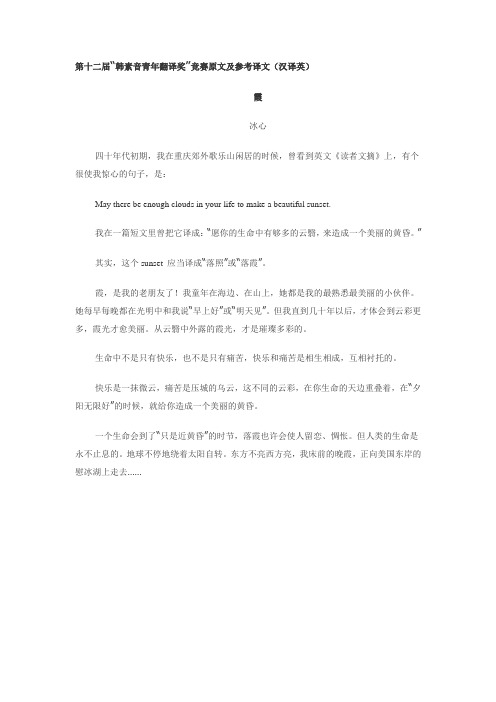
第十二届“韩素音青年翻译奖”竞赛原文及参考译文(汉译英)霞冰心四十年代初期,我在重庆郊外歌乐山闲居的时候,曾看到英文《读者文摘》上,有个很使我惊心的句子,是:May there be enough clouds in your life to make a beautiful sunset.我在一篇短文里曾把它译成:“愿你的生命中有够多的云翳,来造成一个美丽的黄昏。
”其实,这个sunset 应当译成“落照”或“落霞”。
霞,是我的老朋友了!我童年在海边、在山上,她都是我的最熟悉最美丽的小伙伴。
她每早每晚都在光明中和我说“早上好”或“明天见”。
但我直到几十年以后,才体会到云彩更多,霞光才愈美丽。
从云翳中外露的霞光,才是璀璨多彩的。
生命中不是只有快乐,也不是只有痛苦,快乐和痛苦是相生相成,互相衬托的。
快乐是一抹微云,痛苦是压城的乌云,这不同的云彩,在你生命的天边重叠着,在“夕阳无限好”的时候,就给你造成一个美丽的黄昏。
一个生命会到了“只是近黄昏”的时节,落霞也许会使人留恋、惆怅。
但人类的生命是永不止息的。
地球不停地绕着太阳自转。
东方不亮西方亮,我床前的晚霞,正向美国东岸的慰冰湖上走去……The Rosy CloudBingxinDuring the early 1940s I was living a retired life in the Gele Mountains in the suburbs of Chongqing (Chungking). One day, while reading the English language magazine Reader's Digest I found a sentence that touched me greatly. It read: "May there be enough clouds in your life to make a beautiful sunset."In a short article of mine, I quoted this sentence and translated it as "Yuan ni de shengming zhong you guo duo de yunyi, lai zaocheng yige meili de huanghun. " (literally: May there be enough clouds in your life to make a beautiful sunset.) *As I see it now, the word "sunset" in the English sentence should have been translated as luozhao (the glow at sunset) or luoxia (the rosy cloud at sunset), instead of dusk.She has been my dear old friend, the Rosy Cloud! She was my closest and most beautiful little companion when, in my childhood, I played on the beach or in the hills. Bathed in the brilliant sunshine, she would say to me "Good morning!" at dawn and "See you tomorrow!" at dusk. But not until several decades later did I come to realize that the more clouds there are the more beautiful the rays of sunlight will be, and the glow of the sun breaking through the clouds becomes most resplendent and colorful.Life contains neither unalloyed happiness nor mere misery. Happiness and misery beget, complement and set off each other.Happiness is a wisp of fleecy cloud; misery a mass of threatening dark cloud. These different clouds overlap on the horizon of your life to create a beautiful dusk for you when "the setting sun is most lovely indeed."**An individual's life must inevitably reach the point when "dusk is so near,"*** and the rosy sunset cloud may make one nostalgic and melancholy. But human life goes on and on. The Earth ceaselessly rotates on its axis around the sun. When it is dark in the east, it is light in the west. The rosy sunset cloud is now sailing past my window towards Lake Waban on the east coast of America ...*This sentence appears in Chinese and English in the article "For Young Readers Again, Newsletter No.4", written by Bing Xin in the Gele Mountains, on December 1, 1944.** and *** These two poetic lines are taken from a poem "On the Plain of Tombs" by Li Shangyin (813-858), a well-known poet of the Tang Dynasty (618-907). The two lines read like this: "The setting sun appears sublime, / But O! 'Tis near its dying time." (Tr. Xu Yuanchong) They imply that the setting sun has infinite beauty, but it is a pity that it is near the dusk, and the beautiful scene cannot last long. The two lines are often used to deplore the ephemeral nature of things, and to express the feelings at the loss of past glory and at the advent of old age.。
评第十三届韩素音翻译奖英译汉参考译文
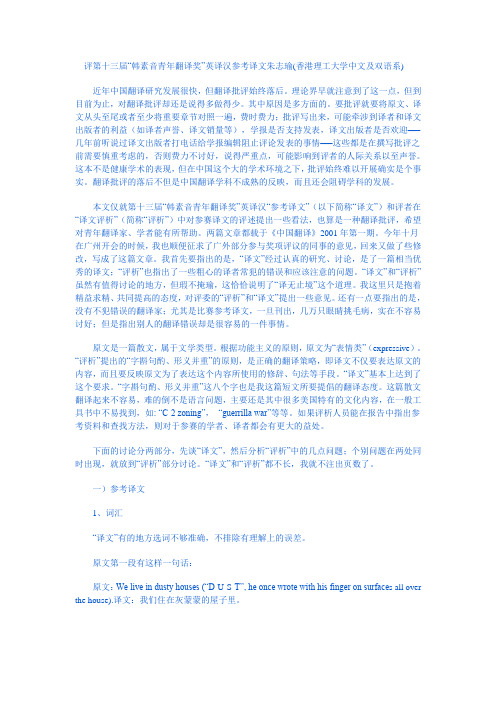
评第十三届“韩素音青年翻译奖”英译汉参考译文朱志瑜(香港理工大学中文及双语系)近年中国翻译研究发展很快,但翻译批评始终落后。
理论界早就注意到了这一点,但到目前为止,对翻译批评却还是说得多做得少。
其中原因是多方面的。
要批评就要将原文、译文从头至尾或者至少将重要章节对照一遍,费时费力;批评写出来,可能牵涉到译者和译文出版者的利益(如译者声誉、译文销量等),学报是否支持发表,译文出版者是否欢迎──几年前听说过译文出版者打电话给学报编辑阻止评论发表的事情──这些都是在撰写批评之前需要慎重考虑的,否则费力不讨好,说得严重点,可能影响到评者的人际关系以至声誉。
这本不是健康学术的表现,但在中国这个大的学术环境之下,批评始终难以开展确实是个事实。
翻译批评的落后不但是中国翻译学科不成熟的反映,而且还会阻碍学科的发展。
本文仅就第十三届“韩素音青年翻译奖”英译汉“参考译文”(以下简称“译文”)和评者在“译文评析”(简称“评析”)中对参赛译文的评述提出一些看法,也算是一种翻译批评,希望对青年翻译家、学者能有所帮助。
两篇文章都载于《中国翻译》2001年第一期。
今年十月在广州开会的时候,我也顺便征求了广外部分参与奖项评议的同事的意见,回来又做了些修改,写成了这篇文章。
我首先要指出的是,“译文”经过认真的研究、讨论,是了一篇相当优秀的译文;“评析”也指出了一些粗心的译者常犯的错误和应该注意的问题。
“译文”和“评析”虽然有值得讨论的地方,但瑕不掩瑜,这恰恰说明了“译无止境”这个道理。
我这里只是抱着精益求精、共同提高的态度,对评委的“评析”和“译文”提出一些意见。
还有一点要指出的是,没有不犯错误的翻译家;尤其是比赛参考译文,一旦刊出,几万只眼睛挑毛病,实在不容易讨好;但是指出别人的翻译错误却是很容易的一件事情。
原文是一篇散文,属于文学类型。
根据功能主义的原则,原文为“表情类”(expressive)。
“评析”提出的“字斟句酌、形义并重”的原则,是正确的翻译策略,即译文不仅要表达原文的内容,而且要反映原文为了表达这个内容所使用的修辞、句法等手段。
第23届韩素音青年翻译奖竞赛参考译文

英译汉原文:Are We There Yet?America’s recovery will be much slower than that from most recessions; but the government can help a bit.“WHITHER goest thou, America?” That question, posed by Jack Kerouac on behalf of the Beat generation half a century ago, is the biggest uncertainty hanging over the world economy. And it reflects the foremost worry for American voters, who go to the polls for the congressional mid-term elections on November 2nd with the country’s unemployment rate stubbornly stuck at nearly one in ten. They should prepare themselves for a long, hard ride.The most wrenching recession since the 1930s ended a year ago. But the recovery—none too powerful to begin with—slowed sharply earlier this year. GDP grew by a feeble 1.6% at an annual pace in the second quarter, and seems to have been stuck somewhere similar since. The housing market slumped after temporary tax incentives to buy a home expired. So few private jobs were being created that unemployment looked more likely to rise than fall. Fears grew over the summer that if this deceleration continued, America’s economy would slip back into recession.Fortunately, those worries now seem exaggerated. Part of the weakness of second-quarter GDP was probably because of a temporary surge in imports from China. The latest statistics, from reasonably good retail sales in August to falling claims for unemployment benefits, point to an economy that, though still weak, is not slumping further. And history suggests that although nascent recoveries often wobble for a quarter or two, they rarely relapse into recession. For now, it is most likely that America’s economy will crawl along with growth at perhaps 2.5%: above stall speed, but far too slow to make much difference to the jobless rate.Why, given that America usually rebounds from recession, are the prospects so bleak? That’s because most past recessions have been caused by tight monetary policy. When policy is loosened, demand rebounds. This recession was the result of a financial crisis. Recoveries after financial crises are normally weak and slow as banking systems are repaired and balance-sheets rebuilt. Typically, this period of debt reduction lasts around seven years, which means America would emerge from it in 2014. By some measures, households are reducing their debt burdens unusually fast, but even optimistic seers do not think the process is much more than half over.Battling on the busAmerica’s biggest problem is that its poli ticians have yet to acknowledge that the economy is in for such a long, slow haul, let alone prepare for the consequences.A few brave officials are beginning to sound warnings that the jobless rate is likely to “stay high”. But the political debate is mor e about assigning blame for the recession than about suggesting imaginative ways to give more oomph to the recovery. Republicans argue that Barack Obama’s shift towards “big government” explainsthe economy’s weakness, and that high unemployment is proof t hat fiscal stimulus was a bad idea. In fact, most of the growth in government to date has been temporary and unavoidable; the longer-run growth in government is more modest, and reflects the policies of both Mr Obama and his predecessor. And the notion that high joblessness “proves” that stimulus failed is simply wrong. The mechanics of a financial bust suggest that without a fiscal boost the recession would have been much worse.Democrats have their own class-warfare version of the blame game, in which Wall Street’s excesses caused the problem and higher taxes on high-earners are part of the solution. That is why Mr. Obama’s legislative priority before the mid-terms is to ensure that the Bush tax cuts expire at the end of this year for households earning more than $250,000 but are extended for everyone else.This takes an unnecessary risk with the short-term recovery. America’s experience in 1937 and Japan’s in 1997 are powerful evidence that ill-timed tax rises can tip weak economies back into recession. Higher taxes at the top, along with the waning of fiscal stimulus and belt-tightening by the states, will make a weak growth rate weaker still. Less noticed is that Mr. Obama’s fiscal plan will also worsen the medium-term budget mess, by making tax cuts for the middle class permanent.Ways to overhaul the engineIn an ideal world America would commit itself now to the medium-term tax reforms and spending cuts needed to get a grip on the budget, while leaving room to keep fiscal policy loose for the moment. But in febrile, partisan Washington that is a pipe-dream. Today’s goals can only be more modest: to nurture the weak economy, minimize uncertainty and prepare the ground for tomorrow’s fiscal debate. To that end, Congress ought to extend all the Bush tax cuts until 2013. Then they should all expire—prompting a serious fiscal overhaul, at a time when the economy is stronger.A broader set of policies could help to work off the hangover faster. One priority is to encourage more write-downs of mortgage debt. Almost a quarter of all Americans with mortgages owe more than their houses are worth. Until that changes the vicious cycle of rising foreclosures and falling prices will continue. There are plenty of ideas on offer, from changing the bankruptcy law so that judges can restructure mortgage debt to empowering special trustees to write down loans. They all have drawbacks, but a fetid pool of underwater mortgages will, much like Japan’s loans to zombie firms, corrode the financial system and harm the recovery.C leaning up the housing market would help cut America’s unemployment rate, by making it easier for people to move to where jobs are. But more must be done to stop high joblessness becoming entrenched. Payroll-tax cuts and credits to reduce the cost of hiring would help. (The health-care reform, alas, does the opposite, at least for small businesses.) Politicians will also have to think harder about training schemes, because some workers lack the skills that new jobs require.Americans are used to great distances. The sooner they, and their politicians, acceptthat the road to recovery will be a long one, the faster they will get there.译文:我们到达目的地了吗?与大多数衰退之后的复苏相比,这次美国经济的复苏会慢得多。
英语翻译之英译汉资料
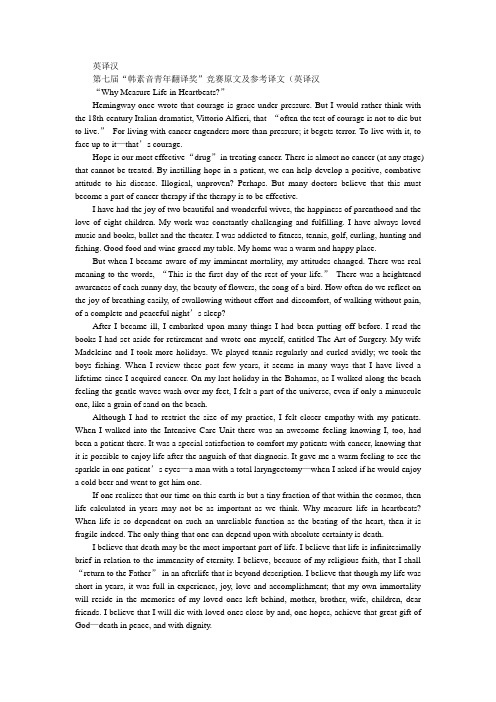
英译汉第七届“韩素音青年翻译奖”竞赛原文及参考译文(英译汉“Why Measure Life in Heartbeats?”Hemingway once wrote that courage is grace under pressure. But I would rather think with the 18th-century Italian dramatist, Vittorio Alfieri, that “often the test of courage is not to die but to live.”For living with cancer engenders more than pressure; it begets terror. To live with it, to face up to it—that’s courage.Hope is our most effective “drug”in treating cancer. There is almost no cancer (at any stage) that cannot be treated. By instilling hope in a patient, we can help develop a positive, combative attitude to his disease. Illogical, unproven? Perhaps. But many doctors believe that this must become a part of cancer therapy if the therapy is to be effective.I have had the joy of two beautiful and wonderful wives, the happiness of parenthood and the love of eight children. My work was constantly challenging and fulfilling. I have always loved music and books, ballet and the theater. I was addicted to fitness, tennis, golf, curling, hunting and fishing. Good food and wine graced my table. My home was a warm and happy place.But when I became aware of my imminent mortality, my attitudes changed. There was real meaning to the words, “This is the first day of the rest of your life.”There was a heightened awareness of each sunny day, the beauty of flowers, the song of a bird. How often do we reflect on the joy of breathing easily, of swallowing without effort and discomfort, of walking without pain, of a complete and peaceful night’s sleep?After I became ill, I embarked upon many things I had been putting off before. I read the books I had set aside for retirement and wrote one myself, entitled The Art of Surgery. My wife Madeleine and I took more holidays. We played tennis regularly and curled avidly; we took the boys fishing. When I review these past few years, it seems in many ways that I have lived a lifetime since I acquired cancer. On my last holiday in the Bahamas, as I walked along the beach feeling the gentle waves wash over my feet, I felt a part of the universe, even if only a minuscule one, like a grain of sand on the beach.Although I had to restrict the size of my practice, I felt closer empathy with my patients. When I walked into the Intensive Care Unit there was an awesome feeling knowing I, too, had been a patient there. It was a special satisfaction to comfort my patients with cancer, knowing that it is possible to enjoy life after the anguish of that diagnosis. It gave me a warm feeling to see the sparkle in one patient’s eyes—a man with a total laryngectomy—when I asked if he would enjoy a cold beer and went to get him one.If one realizes that our time on this earth is but a tiny fraction of that within the cosmos, then life calculated in years may not be as important as we think. Why measure life in heartbeats? When life is so dependent on such an unreliable function as the beating of the heart, then it is fragile indeed. The only thing that one can depend upon with absolute certainty is death.I believe that death may be the most important part of life. I believe that life is infinitesimally brief in relation to the immensity of eternity. I believe, because of my religious faith, that I shall “return to the Father”in an afterlife that is beyond description. I believe that though my life was short in years, it was full in experience, joy, love and accomplishment; that my own immortality will reside in the memories of my loved ones left behind, mother, brother, wife, children, dear friends. I believe that I will die with loved ones close by and, one hopes, achieve that great gift of God—death in peace, and with dignity.何必以心跳定生死?海明威曾经写过,勇气就是临危不惧。
“CATTI杯”第二十七届韩素音青年翻译奖竞赛-英译汉
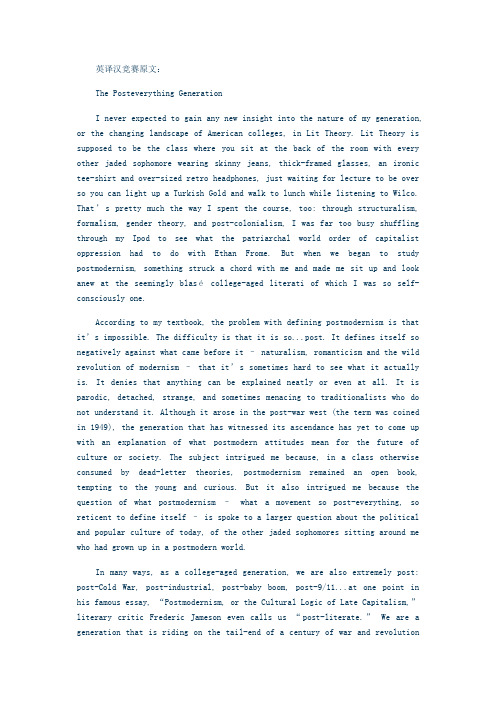
英译汉竞赛原文:The Posteverything GenerationI never expected to gain any new insight into the nature of my generation, or the changing landscape of American colleges, in Lit Theory. Lit Theory is supposed to be the class where you sit at the back of the room with every other jaded sophomore wearing skinny jeans, thick-framed glasses, an ironic tee-shirt and over-sized retro headphones, just waiting for lecture to be over so you can light up a Turkish Gold and walk to lunch while listening to Wilco. That’s pretty much the way I spent the course, too: through structuralism, formalism, gender theory, and post-colonialism, I was far too busy shuffling through my Ipod to see what the patriarchal world order of capitalist oppression had to do with Ethan Frome. But when we began to study postmodernism, something struck a chord with me and made me sit up and look anew at the seemingly blasécollege-aged literati of which I was so self-consciously one.According to my textbook, the problem with defining postmodernism is that it’s impossible. The difficulty is that it is so...post. It defines itself so negatively against what came before it – naturalism, romanticism and the wild revolution of modernism – that it’s sometimes hard to see what it actually is. It denies that anything can be explained neatly or even at all. It is parodic, detached, strange, and sometimes menacing to traditionalists who do not understand it. Although it arose in the post-war west (the term was coined in 1949), the generation that has witnessed its ascendance has yet to come up with an explanation of what postmodern attitudes mean for the future of culture or society. The subject intrigued me because, in a class otherwise consumed by dead-letter theories, postmodernism remained an open book, tempting to the young and curious. But it also intrigued me because the question of what postmodernism –what a movement so post-everything, so reticent to define itself – is spoke to a larger question about the political and popular culture of today, of the other jaded sophomores sitting around me who had grown up in a postmodern world.In many ways, as a college-aged generation, we are also extremely post: post-Cold War, post-industrial, post-baby boom, post-9/11...at one point in his famous essay, “Postmodernism, or the Cultural Logic of Late Capitalism,”literary critic Frederic Jameson even calls us “post-literate.”We are a generation that is riding on the tail-end of a century of war and revolutionthat toppled civilizations, overturned repressive social orders, and left us with more privilege and opportunity than any other society in history. Ours could be an era to accomplish anything.And yet do we take to the streets and the airwaves and say “here we are, and this is what we demand”? Do we plant our flag of youthful rebellion on the mall in Washington and say “we are not leaving until we see change! Our eyes have been opened by our education and our conception of what is possible has been expanded by our privilege and we demand a better world because it is our right”? It would seem we do the opposite. We go to war without so much as questioning the rationale, we sign away our civil liberties, we say nothing when the Supreme Court uses Brown v. Board of Education to outlaw desegregation, and we sit back to watch the carnage on the evening news.On campus, we sign petitions, join organizations, put our names on mailing lists, make small-money contributions, volunteer a spare hour to tutor, and sport an entire wardrobe’s worth of Live Strong bracelets advertising our moderately priced opposition to everything from breast cancer to global warming. But what do we really stand for? Like a true postmodern generation we refuse to weave together an overarching narrative to our own political consciousness, to present a cast of inspirational or revolutionary characters on our public stage, or to define a specific philosophy. We are a story seemingly without direction or theme, structure or meaning – a generation defined negatively against what came before us. When Al Gore once said “It’s the combination of narcissism and nihilism that really defines postmodernism,” he might as well have been echoing his entire generation’s critique of our own. We are a generation for whom even revolution seems trite, and therefore as fair a target for bland imitation as anything else. We are the generation of the Che Geuvera tee-shirt.Jameson calls it “Pastiche”–“the wearing of a linguistic mask, speech in a dead language.” In literature, this means an author speaking in a style that is not his own – borrowing a voice and continuing to use it until the words lose all meaning and the chaos that is real life sets in. It is an imitation of an imitation, something that has been re-envisioned so many times the original model is no longer relevant or recognizable. It is mass-produced individualism, anticipated revolution. It is why postmodernism lacks cohesion, why it seems to lack purpose or direction. For us, the post-everything generation, pastiche is the use and reuse of the old clichés of social changeand moral outrage – a perfunctory rebelliousness that has culminated in the age of rapidly multiplying non-profits and relief funds. We live our lives in masks and speak our minds in a dead language – the language of a society that expects us to agitate because that’s what young people do. But how do we rebel against a generation that is expecting, anticipating, nostalgic for revolution?How do we rebel against parents that sometimes seem to want revolution more than we do? We don’t. We rebel by not rebelling. We wear the defunct masks of protest and moral outrage, but the real energy in campus activism is on the internet, with websites like . It is in the rapidly developing ability to communicate ideas and frustration in chatrooms instead of on the streets, and channel them into nationwide projects striving earnestly for moderate and peaceful change: we are the generation of Students Taking Action Now Darfur; we are the Rock the Vote generation; the generation of letter-writing campaigns and public interest lobbies; the alternative energy generation.College as America once knew it –as an incubator of radical social change –is coming to an end. To our generation the word “radicalism”evokes images of al Qaeda, not the Weathermen. “Campus takeover” sounds more like Virginia Tech in 2007 than Columbia University in 1968. Such phrases are a dead language to us. They are vocabulary from another era that does not reflect the realities of today. However, the technological revolution, the revolution, the revolution of the organization kid, is just as real and just as profound as the revolution of the 1960’s – it is just not as visible. It is a work in progress, but it is there. Perhaps when our parents finally stop pointing out the things that we are not, the stories that we do not write, they will see the threads of our narrative begin to come together; they will see that behind our pastiche, the post generation speaks in a language that does make sense. We are writing a revolution. We are just putting it in our own words.。
- 1、下载文档前请自行甄别文档内容的完整性,平台不提供额外的编辑、内容补充、找答案等附加服务。
- 2、"仅部分预览"的文档,不可在线预览部分如存在完整性等问题,可反馈申请退款(可完整预览的文档不适用该条件!)。
- 3、如文档侵犯您的权益,请联系客服反馈,我们会尽快为您处理(人工客服工作时间:9:00-18:30)。
传统百货会否成为“消失的行业”数据显示,2011年中国电子商务市场整体交易规模达到7万亿元,同比增长46.4%。
电商营销取得的成绩,对传统百货行业的市场占有率是极大的挑战。
越来越多的人去网购,在需求短期之内没有大幅变化的情况下也就意味着相应的百货商场客源流失。
业内人士表示,近年来百货业销售下滑较大的品类也正是方便网络购买的品类,比如家电、IT产品和纺织品,甚至是奢侈品。
同时,一些传统百货商场还面临沦为电商“试衣间”的尴尬。
不少人去实体店确定了衣服等物品的款式、尺寸之后到网上支付购买,由此诞生了“抄号族”、“偷拍党”。
随着网购市场的日益庞大,服装、化妆品和家居用品等都已经纳入涉猎范围,消费者线下选货线上购买。
电商侵占市场之外,行业之内的激烈竞争也不容小觑。
传统百货商场之间同质化较严重,造成同业之间竞争激烈,近年来全国多个城市都在大力建设购物中心等大型商场,使本来就竞争激烈的百货商场经营更加困难。
走在城市的商业街区,几乎所有的百货商场在销售内容、店面设计和产品布局等方面大同小异。
一博士生说,从北京走到福州,看到各个城市的商场几乎是一样的。
“内忧外患”之下,传统百货是否会成为下一个“消失的行业”?多位受访专家表示,传统百货行业面临较大的竞争压力,但并非没有机会。
依靠线上线下一体,差异化竞争,商业模式创新等方式,百货行业或可成功“逆袭”。
据了解,目前“触电”的百货商场并不在少数。
2012年以来,北京的大型百货都相继上线了自己的电子商务平台。
天津百货大楼的电子商务正在筹划实施中。
同时,百货商场应该针对目标客户群体走错位经营、差异化营销的路子。
一博士生导师强调,尽管最近几年百货商场面临的商业环境更加严峻,来自电商和大型商业综合体的竞争更加激烈,但对百货商场的客户群体只是分流了一部分。
百货商场应该深耕目前所占有的客户群体,完善售后服务,探索针对客户的个性化服务。
另外,传统百货应该借助购物中心的发展势头趁机转型。
据了解,零售业的业态构成与人均GDP水平存在一定的对应规律。
人均GDP处于3000美元至5000美元,以大型综合超市为主,在5000美元至1万美元则以购物中心、专卖店、专业店、便利店为主。
而2011年我国人均GDP已经超过5000美元,传统百货业可以趁机向购物中心等方向转变。
汉译英一等奖参赛译文来源:中国译协网CE239Traditional Department Stores: the “Disappearing Industry”?According to the statistics, the total transactions of China’s e-commerce market hit RMB 7 trillion in 2011, with an annual increase of 46.4% compared to the previous year. The achievements of the e-commerce have posed a great challenge to the market share of traditional department store industry. Given no substantial change in demand for the short term, the fact that a growing number of people go online shopping means the corresponding customer loss for the department stores. Insiders said that the categories in the department store industry with considerable sale decline in recent years were precisely those convenient to purchase online, such as household electrical appliances, IT products, textiles, and even luxury goods.At the same time, some traditional department stores also face the embarrassment of being reduced to the “fitting room”for e-commerce. Many people go to the stores to choose the style and size of clothes and other products, and then purchase them online, which gives birth to the so-called “number-copying clan”and “secret-photographing clan”. With the expansion of online market, clothes, cosmetics, household products and other items have all been embraced into online shopping, where the consumers select products at stores and buy online.E-commerce’s occupation of the market aside, intense competition within the industry, which has resulted from serious homogenization among traditional department stores, cannot be underestimated either. Besides, recent years have witnessed a surging wave of building shopping centers and malls by a large number of cities across the country, which adds to the difficulty in operating department stores given the already fierce competition. Almost all the department stores in the commercial blocks present quite similar sale contents, store design and product layout. According to a Ph.D. candidate, the shopping malls of different cities from Beijing to Fuzhou share much resemblance.Under both internal and external pressure, will the traditional department stores become the next “disappearing industry”? Several experts interviewed have said that although the traditional department store industry is facing huge pressure from competition, it does stand a chance. By virtue of the integration of online and offline sale, differentiation competition and business mode innovation, department store industry may successfully “counter-attack”.It is learnt that a considerable number of department stores have “gone online”. Since 2012, large department stores in Beijing have successively launched their online e-commerce platforms. The e-commerce of Tianjin Department Store is currently under implementation as well.Meanwhile, department stores should follow the strategy of differentiated management and marketing in line with target customers. As a Ph.D. supervisor emphasized, although in recent years the department stores faced increasingly severe business environment and intense competition from e-commerce and large commercial complexes, they lost only a portion of their customers. Department stores should further cultivate their current customer group, improve after-sale services and explore personalized service for customers.In addition, traditional department stores should take advantage of the momentum of shopping center for transition. It is learnt that there is a correspondence law between the structure of retail industry and per capita GDP. The per capita GDP of $3,000-5,000 corresponds to large-scale comprehensive supermarkets mainly, while per capita GDP of $5,000-10,000 corresponds to shopping centers, franchised stores, specialty stores, and convenience stores. As China’s per capita GDP has surpassed $5,000 in 2011, traditional department stores should seize the opportunity to transform themselves into shopping centers or other forms.。
